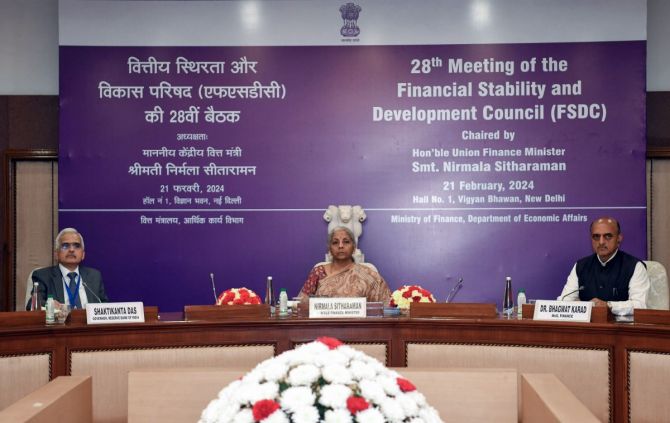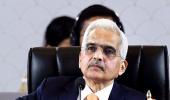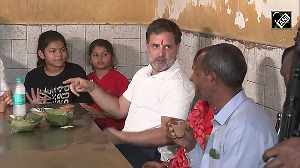'What is this cryptocurrency? Is it a product? Is it a financial product? Is it an asset?'

Shaktikanta Das, governor of Reserve Bank of India (RBI), was in conversation with Tamal Bandyopadhyay, consulting editor, Business Standard, at the newspaper's BFSI Insight Summit 2023 in Mumbai.
Das spoke on a host of issues: talent retention and salaries of bank chief executives, potential risks to growth, cryptocurrencies, corporate governance and internationalisation of the rupee.
Is there a huge challenge before banks to attract and retain talent?
As a part of our supervision, we are also looking at the rate of attrition -- which is seen to be high in certain private sector banks.
We have asked them to look at it because every bank at the end of the day has to build up its core team.
This team should grow with the bank over the years.
Today's youngsters are thinking differently, with so many opportunities, especially coming in the fintech sector and NBFCs (non-banking financial companies).
The youngsters are a very impatient generation and there is nothing wrong with it.
But, I think it's for each bank to build up its own core team because there has to be something called organisational culture.
We are looking at it very closely because we find that the times have changed and banks also need to give greater focus on this rate of attrition.
It's for the banks to really analyse and deal with it. We have not prescribed any norms or standards; we have just left it to the bank management.
Some bankers say that compensation packages come in the way of attracting talent. Some say that RBI is keeping an eye on the salary and perks.
Is it possible for the RBI to be a little liberal?
In private sector banks, the compensation package of only the CEO (chief executive officer) and other whole-time directors comes to RBI for approval.
Everybody knows that it is ultimately the nomination and remuneration committee (NRC) of the bank boards which are expected to decide the compensation package of the banking executives, including the whole-time directors and the CEO.
In almost all cases, except a few, we find that the increase in the package is not commensurate with the business growth of the bank.
On the contrary, if the bank's performance is going down, you cannot have a situation of excessive increase in the compensation package.
So, in very few cases where such things happen, we put some restrictions.
In most of the cases, we return it to them saying, "Please relook and come back to us." So, we do not put any restrictions on that.
Congratulations on India's inclusion in the JP Morgan Bond Index. But has it come a little faster than you expected because you need to prepare the ground?
We need to have more of those particular bonds in which the foreign investors are allowed to invest in; we need to have more liquidity.
Our effort over the last few years has been to expand the investor base in our securities market, especially the government securities market, and also to provide greater opportunity for participation.
We have taken several steps like permitting domestic banks to offer margin facilities to the FPIs (foreign portfolio investors).
Inclusion of India in the JP Morgan Bond Index is their decision.
It is a vote of confidence in the Indian financial markets.
JP Morgan has given an estimate of $25 billion to come over a period of time -- all that is expected.
On the other side, it is a double-edged sword. There are many passive investors who are influenced with your weightage in the index.
So the reverse can also happen. When your weightage goes down, the passive funds will immediately tend to move out or if there is some other development globally, it can lead to outflow of funds.
I would like to mention that RBI has a track record over the years, and especially in the recent period of handling large scale inflows and outflows.
I think the overseas investors have greater confidence in India's and RBI's ability to service the outflow of currency.
There was never a doubt that RBI would not be able to meet the dollar requirement because of the reserves which we had built up.
When outflows happened after the Ukraine war, it was handled in a very seamless manner.
When there were large scale inflows before that, we utilised the opportunity to build up our reserves.
So, we have a track record of handling both sides of the so-called double-edged weapon of bond inclusion -- we can handle large scale inflows, we can handle large scale outflows.

There has been a rising focus on corporate governance. You have had multiple meetings with them and called their boards. There have been certain problems with certain banks.
Stock market accordingly rewards or punishes the banks. But you don't talk much about it. What is your approach to governance?
The Indian banking system and NBFC sector at the moment are healthy and robust.
Their financials are robust and healthy at the aggregate level as well as the individual entity level.
Now, governance is something beyond these numbers. These numbers ultimately in the long run, flow out of good governance.
Our emphasis has been on good governance to ensure that these numbers that they have been achieved over the years due to multiple measures taken by the RBI and the government continue and improve further.
We want, firstly, these numbers to continue and improve further; secondly, we want underlying these numbers, certain basic deficiencies should not get camouflaged.
What differentiates a good institution of banking or an NBFC from a not so good one is the governance.
We are highlighting three components: Strong robust risk management, compliance culture including ethics, and the strength of internal audit.
Wherever we see any deficiencies or any deviations or any problem building up somewhere, our job is to immediately flag the issue with the entity.
We do not want to hit big headlines making statements that such a bank has a problem.
In the public perception, the interpretation may be disproportionately high or excessively high compared to the actual nature of a governance deficiency.
We quantify that deficiency and want the bank to take corrective measures.
Our supervisory teams are in direct touch with the management of the banks.
We have been doing a thorough verification and inspection of the quality of the IT system in banks and what kind of cyber-security facilities they have.
When we emphasise governance, we do not want to create unnecessary panic when there is no reason to panic.
You are also looking at the business models of the banks. Is it the regulator's job to teach bankers how to do banking, what should be the business model?
We are not interfering with the micro-level business models. When we say business model, it is from the point of view of the structure of the balance sheet of the bank.
What kind of risk appetite is being reflected in the bank balance sheet, whether that risk appetite is matched or backed by adequate risk mitigation measures.
So, we are looking at more of structural issues in the balance sheets, we are also looking at the revenue models of the banks, short-term risks, short-term gain versus long-term risks.
We are looking at issues which every banker does: The asset-liability balancing whether they are appropriately managed.
A problem, which looks small in some corner of the balance sheet of any financial service provider, can become highly risky unless it has been properly understood and properly mitigated.
For the last few years, we have adopted risk-based supervision.
You have to look at what risks the banks are taking and whether it has been properly addressed by the bank in the balance sheet.

The risk management and disclosures also rule out any possibility of a Silicon Valley Bank, right?
After the recent developments, particularly in the United States and in Switzerland where there were some bank failures, I think once again the central banks and the banking sector regulators and supervisors have woken up to the fact that they need to do much more intensive supervision.
The supervision had somewhat fallen behind the curve.
I can say with confidence that our supervision has by no means fallen behind the curve.
It has remained in sync with the requirements of the growing complexities of the financial sector.
Banking sector supervisors in several countries have started looking at the business models of the banks.
The failure of the particular bank in the United States had a lot to do with the business model.
The bank management is the first line of defence, the central bank is not supposed to do risk management.
We are not looking at the commercial aspects of their business models.
We are looking at the overall risk matrix, the risk appetite, the risk mitigation and the structure of their balance sheet.
There has been a shift towards rule-based regulations for NBFCs. Upper class NBFCs are treated almost at par with the banks.
Is this a way for the RBI to persuade the large NBFCs that it is better to become a bank?
There are fundamental differences between NBFCs and banks, like the entry limit.
For banks, the new applicant will have to provide Rs 1,000 crore of equity capital whereas for an NBFC registration it is still Rs 10 crore.
Then there are other requirements like cash reserve ratio etc.
Overall, the NBFC sector also enjoys certain flexibility with regards to lending.
For example, in the case of banks, they are expected to have board-approved policy for sectoral caps -- exposure they should take to which particular sector.
There are requirements mandated by the RBI.
It is different for NBFCs. The larger NBFCs are doing it themselves by way of prudent management.
It would not be correct to say that we are nudging upper layer NBFCs to come as banks, but it is always open to any upper layer NBFC or anyone for that matter to apply for a banking licence because it is 'on tap'.
Anybody can apply at any point in time. Of course, it has to satisfy our 'fit and proper' guidelines and other requirements.
Everyone is now talking about the internationalisation of Rupee. Considering the size of the economy and the size of exports, how much is talk and how much is reality?
Internationalisation of the Indian rupee is not a target, it's a process and there is a phased road towards greater internationalisation of the rupee.
The size, the presence and the impact of the Indian economy in the global scenario is also expanding.
IMF (International Monetary Fund), in the recent 'World Economic Outlook' report, said that India is going to be the fastest growing major economy in the current year as well as perhaps in the next year.
So, the size of the Indian economy is growing and the contribution of the Indian growth in the mix of world growth is now in the order of 15 per cent.
And recently, I think the director-Asia-Pacific of the IMF said in a press interaction that, by 2028, India should be contributing to 18 per cent of world growth.
The size and presence of the Indian economy is growing.
In this scenario, the presence of the Indian rupee in various international transactions is something which should also happen.
We are looking at it because dependence on one currency for international trade for any economy has its risks.
Let me stress we are not pitting the rupee against the dollar. It's not a question of the rupee versus the dollar, the dollar is the dominant currency and will perhaps remain the dominant currency for international trade for years to come.
But, what we're looking at is to increase the footprint of the Indian rupee in international trade, especially with regard to countries with which India has very close and active trade relations.
So, we have signed the MOU with the United Arab Emirates for rupee denominated or the local currency denominated export-import.
Sri Lanka has already recognized the Indian rupee as a designated currency for international trade.
We have also entered into similar MOU with other countries.
And the UPI linkage is also simultaneously being pushed.
We have also provided the facility of opening a vostro account and whereby the entire import-export will be settled by using the Indian rupee.
We are trying to widen the footprint of the Indian rupee in the context of India's trade with other countries, where we have better trade relations.
It is a process we are moving towards and something that we feel should happen as India becomes a bigger and bigger economy.
The latest IMF-FSB report talks about not banning but regulating cryptocurrencies. Is there any plan on that, as some countries may say yes and Indians might start using money overseas for crypto.
You are a staunch believer in banning it. Please give us some clarity.
It's a very serious issue. It's a very serious threat to financial stability for all countries, for global financial stability, especially for the emerging market economies.
And, that is something which has been recognised in the IMF-FSB synthesis paper also.
And incidentally, the IMF-FSB synthesis paper also says very clearly that based on country-specific requirements, especially emerging market and developing economies, may impose additional restrictions with regard to cryptocurrencies.
The risk is very well recognised in the BIS paper on cryptocurrencies and everybody understands and agrees that there are serious risks.
That risk has to be looked at and managed very, very carefully.
I have seen comments from certain quarters, especially from those who are in the crypto business.
They are critical of the RBI stance.
We have to look from the overall perspective of macroeconomic stability.
I'm not going into the details of what threat it poses to monetary stability, currency system, or financial stability.
To the believers of crypto regulations, I have only one question to ask, how will you regulate it?
Whom will you regulate? And regulate what? And before you think of regulating it, let us first understand, what is this?
What is this cryptocurrency? Is it a product? Is it a financial product? Is it an asset?
If it's an asset, what is the underlying -- it's not a tangible thing? What is the definition of cryptocurrency?
Till now, I am yet to see a credible definition of what cryptocurrency is.
I have yet to come across a critical explanation on what is the larger purpose that cryptocurrencies serve.
What is it that cryptocurrencies will do for international or domestic transactions which CBDC cannot do? It is a new currency system.
Are governments and central banks across the world comfortable with private currency, vis-a-vis fiat currency or currency issued by a central bank on behalf of the sovereign? These are fundamental issues that need to be discussed before we talk of any kind of regulation.
We are not against innovation, but innovation should serve a public purpose.
If the way the FDI flows continues, there could be pressure on the currency. There are a lot of global uncertainties.
Can we have an independent monetary policy? Is India decoupled or could there be a situation like that?
There have been equity related outflows. In July and August, we saw very strong inflows into the Indian market.
It was only in September and October that there were outflows.
And there have been equity related outflows also, but I want to set the record straight.
The outflows are not entirely because of equity related.
In fact, the equity related as a percentage of the total outflow is much less.
Outflows are mainly related to payments for imports, repayment of earlier ECBs (external commercial borrowings).
For our monetary policy, we look at all possible international factors because we are living in a globalised world.
But, ultimately and eventually our monetary policy is primarily determined by domestic factors.
By domestic factors, I mean, what is the inflation growth outlook that we have, what is our anticipation with regard to inflation trajectory, with regard to growth trajectory as provided in the RBI Act.
Our monetary policy is not influenced by what is the differential in bond yields, or if currency is depreciating.
Many countries do interest rate hikes to manage the pressure on their currencies.
Recently, I think Indonesia probably did it.
Singapore has a monetary policy framework where they don't have inflation as a target, they have a band for exchange rate as the principal target.
We look at international factors, we take it into consideration as we are living in a globalised world.
Eventually our monetary policy is dependent on inflation and growth dynamics.

You have always said that India is the global growth engine. We are just a few weeks away from the general elections.
Then there is geopolitics. Are there any concerns which can derail the growth?
With regard to the concerns, I think the biggest challenge to every country, not just India, is the evolving geopolitics and its fallout with regard to financial markets and global growth.
New flashpoints and new geopolitical conflict points are developing.
How the geopolitical conflicts are going to play out, whether there are new flashpoints coming up.
Therefore, it is the geopolitical uncertainty, which I think is the biggest risk to global growth.
But so far as India is concerned, even with all geopolitical risks, I can say with confidence that India is better placed compared to other countries to deal with such risky or such potentially risky situations.
What is your message for the financial markets?
Please play long term, play like Rahul Dravid.
Feature Presentation: Aslam Hunani/Rediff.com













 © 2025
© 2025